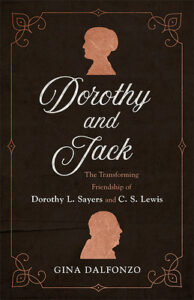 Summary: The 15 years of friendship between Dorothy Sayers and CS Lewis, primarily via letter, helped shape and encourage them.
Summary: The 15 years of friendship between Dorothy Sayers and CS Lewis, primarily via letter, helped shape and encourage them.
History is always a balance between the 30,000-foot overviews and the small, close looks at seemingly little things that allow us to understand the people, not just the large movements of history. I routinely move back and forth between the large and small, often in waves. Right now, I am mostly at a point of wanting the smaller textured history, memoirs, and close connections with people. Dorothy and Jack is precisely a close reading of a small slice of history that is important to give context to the larger historical sweep.
A few years ago, I was trying to read a book a month by or about CS Lewis. He strongly influenced post-WWII American Christianity, and it felt important to understand Lewis to understand my Christian context better. (And Lewis is just a fascinating figure and an excellent writer.) I am far less familiar with Dorothy Sayers. I have read nine or ten of the books from her mystery series. Still, I have not read her influential essay that shaped the American Classical School movement, her apologetics, any of her plays, or her translations of Dante. I have not read a full biography of Sayers, although I have read at least five full biographies of Lewis. So, while I know of Sayers, my connection with the two does have a disparity between the backgrounds.
Gina Dalfonzo, in part, because so much of their relationship was epistolary, can quote and build the picture of their friendship from their own words. Both were established writers by the time they struck up their friendship, and they admired one another’s work, although Lewis was not a fan of the Lord Peter Wimsey mystery series. The friendship was mainly about their writing and being the type of friend who can share their work.
It was a familiar feeling for me when I read about Lewis’ idealizing the era of the letter. We have so much information from people of earlier generations from their letters. I do not envy biographers working a hundred years from now who will have to sift through thousands of hastily written emails and text messages with incomplete sentences and many autocorrect errors. Letters of those earlier generations were not perfect, but it was common to draft and send a cleaned-up copy, so there was a level of care and thought put into letter writing. The postal system in the Lewis/Sayers era was rapid and often had more than one delivery a day.
I do not want to idealize letter writing inappropriately. As Dalfonzo points out, letter writing is still a written medium that has opportunities for misunderstanding. And it took years to develop the level of intimacy that Lewis and Sayers developed. Cross-gender friendships are still controversial in some circles, but I am convinced that they are part of what makes healthy adults. Lewis has had a lot of criticism for his portrayal of women in his writing. Dorothy and Jack makes the argument that Sayers did help improve Lewis’ writing about women and soften his attitude toward women in ways that may have prepared him for his later marriage to Joy Davidson.
I slowly worked my way through Dorothy and Jack as a bedtime book, reading a few pages before bed each night for a couple of weeks. The writing is solid and intimate, as is appropriate in a book about friendship. Like any good book, Dorothy and Jack makes me want to read more. In this case, I want to find a copy of her play series, The Man Born to be King and a complete biography of Sayers.
Dorothy and Jack: The Transforming Friendship of Dorothy L. Sayers and C. S. Lewis by Gina Dalfonzo Purchase Links: Paperback, Kindle Edition, Audible.com Audiobook